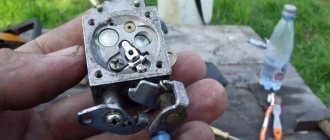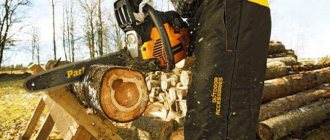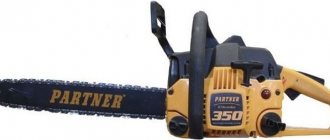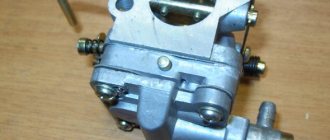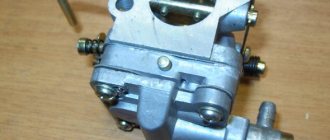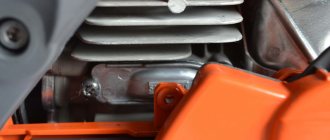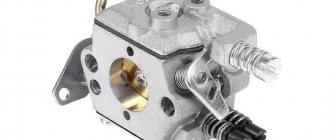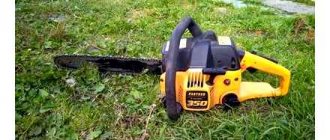When carrying out construction and repair work at the dacha, it is impossible to do without the use of a gasoline saw. The same can be said about gardening. If this tool fails, all work will come to a standstill, so it is very important to be able to independently find and fix faults. If you have some experience, you can adjust the carburetor yourself. Although this procedure is quite complex, anyone can learn to perform it if they have the desire.
The need for adjustment
The need to adjust the carburetor of the Partner-350 gasoline saw arises quite rarely. Most often, problems that arise are related to engine wear or improper fuel supply. You can determine when the need arises to adjust the mechanism based on several criteria. One of them is that the engine stalls immediately after it has been started. In other cases, it is not possible to start it at all. Such problems are caused by excess oxygen or lack of fuel. A malfunction may occur when fuel consumption increases, resulting in an increase in the volume of exhaust gases. The reason for this process is the oversaturation of the fuel mixture with fuel.
Scope of practical application
The tool is designed to perform small-scale work directly related to clearing areas of old trees, preparing winter firewood supplies, longitudinal, transverse and diagonal sawing of wooden and wood-based building materials.
Despite belonging to the household class, the tool has elements of equipment typical for saws of the semi-professional category. In the basic version it is:
- two-stage air purification scheme;
- availability of a quick start system;
- automatic saw chain lubrication;
- inertial emergency stop brake.
Mechanical causes of failure
The need to regulate the carburetor of the Partner-350 chain saw may also be due to mechanical failures. For example, strong vibrations can damage the protective cap. As a result, the rigid fixation of the bolts in the carburetor is weakened.
Another possible reason is wear of the piston part of the engine. In this case, adjusting the carburetor allows you to use the unit for some time, but to fix the problem, you need to replace the worn part. Another reason may be a blockage that occurs when using low-quality fuel. Scale build-up and filter damage can lead to such consequences. To eliminate problems that have arisen, the carburetor must be disassembled, thoroughly washed and then adjusted.
Modification
Based on the chainsaw, a technically improved version of the Partner P371XT Chrome has been developed. The modernized saw is distinguished by the presence of a vibration damper and booster pump, with increased power to 2.2 hp.
The detailed instructions included in the factory kit contain recommendations on preparing the tool for operation, self-service, and selecting algorithms for searching and eliminating possible failures.
The spare parts available in the range allow the owner to repair the saw with relatively low material costs.
Carrying out disassembly
Before you begin adjusting the carburetor of the Partner-350 gasoline saw, it is necessary to study the design of the unit in detail. Since it is used almost unchanged in many models, the recommendations below are relevant for the vast majority of them.
When removing elements, you should be as careful as possible, laying them out in the same order in which they were dismantled. This will make the subsequent assembly easier. The top cover is held in place by three bolts, they need to be removed. After this, a layer of foam rubber will become visible, serving as an air filter element. To remove the drive rod, you need to get rid of the gasoline hose. It is impossible to adjust the carburetor of the Partner-350 chain saw without removing the cable tip; this must be done at the next stage. The fuel hose located on the left side of the fitting must be removed. After completing all the above procedures, you can disconnect the carburetor and begin adjusting it. This mechanism is very complex, for this reason, during subsequent disassembly, extreme care must be taken when removing parts. Without this, they are easy to lose due to their small size.
Basic faults
The following types of faults are typical for the Partner chainsaw:
- engine malfunctions, such as problems with ignition, fuel supply, or exhaust and piston-cylinder systems;
- failure of carburetor components, such as the clutch assembly, chain brake or lubrication system.
The causes of failures can be different, but most often it is improper operation, insufficient amount of oil or poor-quality fuel mixture.
How to remove and disassemble
Correcting malfunctions of a chainsaw carburetor is possible only after this part has been removed. And to do this you need to disassemble the chainsaw itself. This work will have to be done in the following sequence:
- Remove all components in strict order. First the chain brake cover and saw set, then the top cover, saw handle and starter.
- After these parts are removed, you need to clean the saw using a compressor with an attachment.
- After this, you need to plug the inlet window, since there is a risk of dirt and foreign objects getting inside.
Cleaning
You can clean the carburetor in different ways, most often it is done with air. The sequence of work is as follows:
- Unscrew the top bolt of the part cover.
- Remove the valve gasket. After this, you need to blow the mesh with compressed air. In this case, you should not blow closely, but at a short distance.
- There is no need to remove other parts of the carburetor. You can use a special liquid to clean the surface.
- Now the carburetor needs to be assembled, attaching the parts in the reverse order.
Other renovations
For the Partner chainsaw to operate efficiently, other repairs may be required. It is not difficult to carry out repairs with your own hands.
The most common problem is the lack of:
- sparks in the spark plug (you need to either clean the gap on the spark plug, or replace the coil or flywheel with similar parts);
- fuel supply (the cause may be a clogged hose or fuel filter);
- air supply (air filter needs to be washed).
Carrying out the adjustment
Owners of the Partner-350 chain saw can adjust the carburetor on their own, without turning to professionals for help. Of course, you should adequately assess your capabilities and skills. If you have confidence in your abilities, you can begin disassembling in accordance with the recommendations indicated above. You can then begin making adjustments and further adjustments. In some models of the Partner chainsaw, a single screw is installed, but most often there are three. They need to be distinguished. The manufacturer designated each of them with its own letter, which helps to understand the purpose of each element. The screw marked H is for adjusting the high speed. The screw marked L is used when adjusting the lower speed. The idle speed is adjusted using a screw marked T. Models with one screw only have this element.
Advantages and disadvantages
According to experts and users, the design and operating capabilities of the tool meet the requirements of current regulatory documents:
- Due to the use of an engine with a balanced crankshaft, the absence of a vibration damper has virtually no effect on operator comfort.
- The performance of complex sawing work is increased due to the convenient shape and modern design of the body, moderate weight, excellent balance, smooth chain movement and ergonomic shape of handles that are comfortable for a secure grip.
The most frequently mentioned disadvantages include moderate wear resistance of guide bars and chains, and the lack of visual control of the fuel and oil levels in internal tanks.
Additional recommendations
After purchasing a Partner-350 chainsaw, you can adjust the carburetor while using it. Before starting this work, please note that the settings installed at the factory are optimal. Using the screws described above, you can adjust the operation of the engine in special cases when extraordinary external circumstances require it, for example, individual climatic conditions. When adjusting, use the screws marked with the letters H and L. To reduce the speed, they must be turned counterclockwise. To increase the speed, you need to turn the screws in the opposite direction.
The required sequence of screw use is of great importance. It looks like this: L – H – T. If difficulties arise during the adjustment process, it is advisable to promptly seek help from a professional, since incorrect adjustment can cause engine damage.
Chainsaw Partner BP-45
Manufacturer: Partner
Model: BP-45
Description Chainsaw Partner BP-45
Chainsaw Partner BP-45: designed for sawing logs and wood materials, pruning trees, felling trees, etc. The chainsaw is characterized by greater mobility and higher productivity, unlike an electric one. The disadvantages of a chainsaw include more complex maintenance, as well as sensitivity to the quality of gasoline and oil used. The PARTNER BP 45-3.0 chainsaw is lightweight, convenient and maneuverable, which will allow you to work with this tool without much effort and experience.
Characteristics Chainsaw Partner BP-45 Technical characteristics Bar length 45 cm Engine power 3 hp (2.3 kW) Idle speed 2800 rpm Oil tank volume 260 ml Fuel tank volume 550 ml Additional information Warranty Check with the manager Equipment Tire and chain, screwdriver wrench, measuring bottle
Need for adjustment
To understand how the Partner-350 gasoline saw is adjusted, you need to study the design of this unit in as much detail as possible at the first stage. Understanding the principles of its operation and becoming familiar with the features of its parts will help you identify the cause of the malfunction on your own. The carburetor is one of the main components of the engine. Its purpose is to prepare and further supply a fuel mixture consisting of gasoline and oxygen. If the required proportions of these ingredients are violated, the engine begins to function incorrectly, and subsequently fails completely.
What to do if the muffler is clogged
If the chainsaw engine functions normally at low speeds, but smokes and stalls at high speeds, then the reason is most likely in the muffler. Remove it first, but be sure to close the outlet.
Then disassemble and clean from carbon deposits using a dry method or detergents, dry with a hairdryer, assemble and install.
The Partner 350 chainsaw, popular among gardeners, successfully combines endurance, the ability to cope with the most complex household tasks and efficiency. This model tolerates operation well in difficult weather conditions, which makes it possible to use it both in summer and winter, without the risk of unexpected breakdown of the main working units
Carburetor design
After making a decision to adjust the Partner-350 chain saw, the first thing you should do is study the design features of its parts. The most important component of the system is the diffuser, which serves as a constriction device to increase the flow rate of the supplied oxygen. The diffuser is located directly next to the inlet through which fuel is supplied. The flow of incoming oxygen is regulated using a tube with a transverse damper included in the carburetor design. Fuel is supplied through a needle-shaped nozzle. The carburetor design also includes a float chamber, the purpose of which is to regulate the fuel supply at the entrance to the channel.
Headset
The working unit includes a removable 16-inch guide bar and a saw chain with a tension mechanism. Cooling and lubrication of the headset is realized through an automatic system equipped with a variable displacement pump and a 200 ml oil reservoir.
Oil is supplied to the working area in measured quantities, depending on engine speed; the advantages of this design are significant savings in consumables.
The emergency stop mechanism blocks the chain when the tool is thrown away or when another traumatic situation occurs. The inertial brake is activated by moving the protective device forward. The function of blocking a broken chain is assigned to the built-in catcher.
Principle of operation
Owners of a Partner-350 gasoline saw may encounter the need to adjust the carburetor while using this equipment. In order to carry out this procedure properly, great attention should be paid to becoming familiar with the operating principle of this technical element. As a result of the fuel being atomized in the diffuser by a stream of air, a mixture is formed and injected into the cylinder. The larger the volume of fuel supplied, the higher the engine speed. The functioning of the carburetor in the described equipment model occurs in accordance with the diagram described above. Other models use the same scheme.
Specifications
The small-sized, wide-functional saw Partner 371, weighing 4.7 kg, is not inferior to the best models in the semi-professional category in a number of characteristics. The tool is powered by an economical and easy-to-maintain carburetor power unit with a cylinder capacity of 37 cm3 and a power of 1.9 hp.
The fuel mixture is prepared from motor gasoline with the dosed addition of motor oil for high-speed two-stroke internal combustion engines. The battery life has been extended by increasing the fuel tank volume to 370 ml.
| Model | Partner 371 |
| Manufacturer | Partner |
| Production (assembly) | USA |
| Homeland of the brand | Sweden |
| Saw class | Household |
| Power, hp (kW) | 1,9 (1,4) |
| Engine volume, cm3 | 37 |
| Chain pitch, inches | 3/8 |
| Chain thickness, mm | 1,3 |
| Number of links | 56 |
| Fuel tank volume, l | 0,37 |
| Oil tank volume, l | 0,2 |
| Tire length, cm (inches) | 40 (16) |
| Noise level, dB(A) | 104,3 |
| Warranty, years | 1 |
| Weight, kg | 4,7 |
| Instructions |
Ignition adjustment
Owners of the Partner-350 gasoline saw have to adjust the ignition quite often. When starting the equipment for the first time, it is necessary to check the idle speed. To do this, you need to turn the screw clockwise, which is responsible for regulating the idle speed. After it rests, you should turn it four and a half turns in the opposite direction. If, after performing these manipulations, the engine operates without rotating the chain, we can conclude that there are no problems. Otherwise, you need to contact a service center for help, since using a chainsaw in this condition can be dangerous.
Chainsaw Partner 350: DIY repair, video
Today, almost every household has a chainsaw, which is a worthy replacement for axes and hand saws. The ideal solution for people living in a private home or involved in construction would be the Partner 350 hand chainsaw. This tool from a Swedish manufacturer is very convenient and compact, so it is suitable for any work in the garden.
READ How to Start a Chainsaw After a Long Idle Time
However, improper care and intensive use of the unit can lead to its breakdown. In this case, it is not necessary to immediately contact a service workshop. Many problems can be fixed with your own hands. To do this, just study the structure of the saw and video instructions for its repair.
Repair of cylinder-piston group
In this group, problems are quite rare. If any element breaks, it is most often replaced with a new one.
Main malfunctions of the cylinder-piston group:
- Engine power may be lost due to low (about 5 atm) pressure in the cylinder. To measure it, you need a special pressure gauge called a pressure gauge. The normal operating pressure of the cylinder is 8-9 atmospheres.
- If hot gases are released into the engine crankcase, the piston rings most likely become stuck.
- Loss of pressure and release of gases through cracks may indicate destruction of the cylinder head gaskets. They need to be replaced.
The condition of all elements of this group can only be fully assessed visually, through the hole from the removed muffler. If this is possible, then the cylinder head or the entire cylinder is removed.
If the cause of the chainsaw breakdown is unimportant, then it does not matter whether the tool was made by Russian or Chinese manufacturers. Disassembling and repairing the unit can be done quite easily with your own hands, having first studied its design and video instructions for troubleshooting.
Common Partner saw breakdowns: diagnostics at home
The Partner gasoline saw cannot be called unreliable. For many users it works without problems in winter and summer, for many years. But others complain about the same typical problems:
- The chainsaw won't start.
- The chainsaw starts but stalls.
- Fuel does not enter the cylinder.
All these problems have internal causes in the parts and components of the tool. This means that in order to get to the bottom of it and fix the breakdown, you will have to disassemble the electric saw. This is not as difficult as it may seem, because manufacturers always take this possibility into account.
To independently diagnose problems at home, you need to understand that common chainsaw problems in the vast majority of cases are caused by the same reasons. Therefore, just by the symptoms, you can guess where the source of the problem is.
For example, if a chainsaw does not start, then the reason most likely lies in the ignition system, namely the spark plug. If air leaks into the cylinder, then you need to look for a defect in the fuel system. A dirty filter causes the engine to stall and smoke, and so on. Let's look at these cases in detail so that you feel confident when repairing the Partner chainsaw yourself.
Owner reviews
Thanks to cheap spare parts, Partner 371 was restored by me literally from scrap metal. The design is simple, and with proper assembly it is not difficult to obtain the desired result. I've been cutting wood for two years now without any significant problems. Nikolay
I am using a well-worn Partner with a 14-inch tire that already has some life remaining. Over many years of use, there was everything good and bad, but the overall impression of this model is positive. The condition of the tool is still working, if it fails thoroughly, I will take the Chrome model with a 16-inch tire and a built-in vibration damper. Arkady Vasilievich
